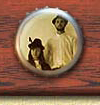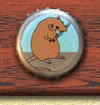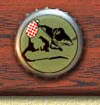THE VB GLASS COLLECTION
![]()
Glasses from Belgium
in no particular order
Kwak glass with stand
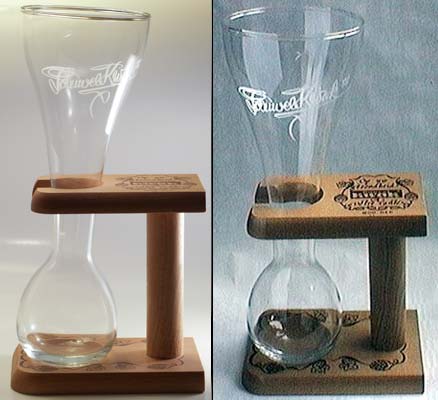
No glass collection would ever really be complete without this most distinctive Kwak glass. Its odd appearance also makes for an odd drinking experience. Every time one takes a drink, the beer sloshes through the narrow neck near the base of the glass. This causes a rather loud "kwak" sound, causing others who are not also drinking from a Kwak glass to give you furtive glances. The glass can not easily be set down without its accompanying wooden stand. The stand is covered with lovely dark brown hop decorations and the words "Op uw gezondheid" and "A votre santé" (both meaning "to your health" in Dutch and French respectively).
As for the beer itself, it was first brewed in 1839 by Pauwel Kwak from the Brouwerij Bosteels. He created this 8.0% strong beer along with its special glass in order to attract more customers. It is therefore logical that it is his signature which is painted on the glass.
Tripel Karmeliet glass
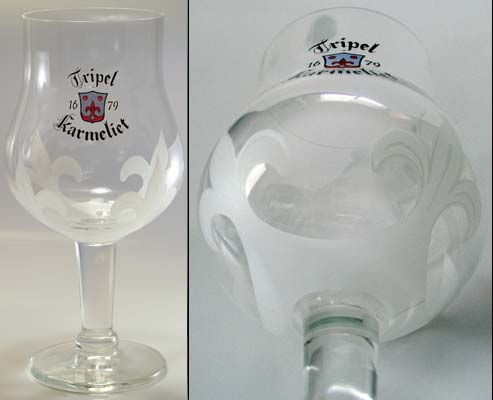
Brouwerij Bosteels also makes this beautifully sculpted glass. The name of the beer, the year of the recipe, and a coat of arms are all clearly displayed on the front of the glass. Underneath, frosted fleur-de-lis shapes cup the bowl of this very large yet surprisingly light glass. The wide foot at the base comes in very handy to balance the large amount of tasty liquid that this glass can hold.
The brewery, founded in 1791, is located in Buggenhout, a city in the northern province of Brabant.
Chouffe Bok glass
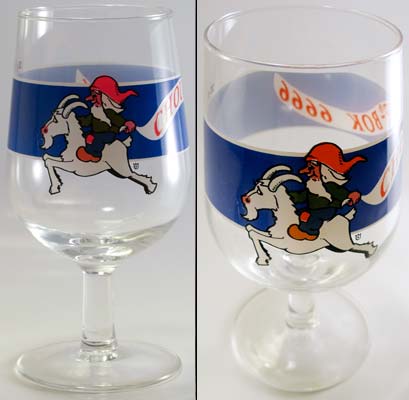
This glass is part of a long story. Every year, the Brasserie D'Achouffe (located in the province of Luxembourg) produces a special, painted bottle that tells the stories and travels of the "cabouters" or gnomes. Supposedly the cabouters are masters of brewing, and at one point in history, their beer used to flow forth like rivers across Belgium.
The picture on the glass is of one of these cabouters on his means of transportation, his flying goat. The bright colors stand out clearly when the glass is filled with the dark tasty Chouffe Bok beer. The 6666 is actually just the brewery's postal code, although the number finds its way into many aspects of the beer, including the 6.666% alcohol content.
Houten Kop glass
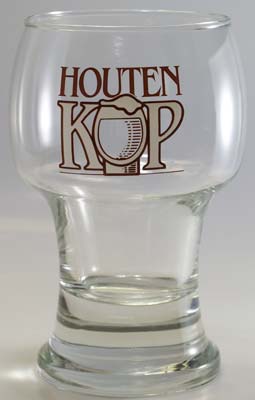
Houten Kop literally translates from Dutch to "wooden head", and has to do with the expression "een houten kop hebben" or "to have a hangover". And with this 6.5% alcohol beer, that might not be surprising after a few bottles.
The glass also seems to be designed with some heavy drinking in mind: the base of the glass is narrow yet stout, making it easy to get a good grip on; it has a thick heavy glass bottom, to prevent it from tipping over easily; and last but not least, the glass is broader at the top, which can allow for plenty of toasting, without getting one's fingers caught in each blow.
Brouwerij Strubbe is located in the Dutch speaking province of West-Vlaanderen.
Bosbier glass
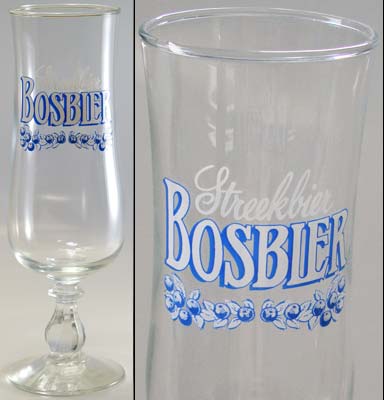
Just as there are many different types of beers, there are many different types of glasses to match. Any glass specifically designed for a particular beer is intended to enhance the enjoyment of the beer, for example by allowing the beer to be more aromatic or accentuate its color.
The glass chosen for Brouwerij St. Jozef's Bosbier (or 'forest beer' when literally translated from Dutch), is a tall slender glass. This shape is common for many fruit beers or Belgian style witbiers. The blue and white design located underneath the text is of some type of wild forest berry (probably blueberry). "Streekbier" simply means "regional or local beer".
Bokkereyer glass
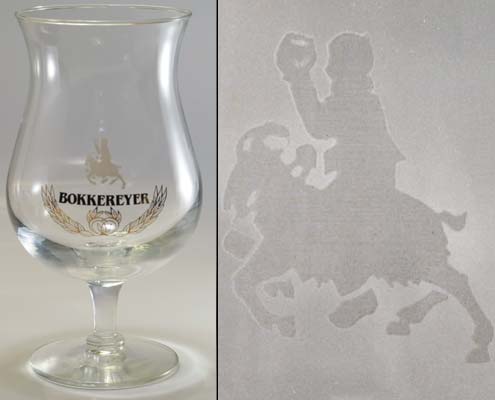
The same brewery also gives us this glass. For their 6% "Luxury Beer", they have chosen a beautiful bowl glass. Bokkereyer is translated from Dutch as "bock or goat rider", as clearly the image on the glass shows us. Note the large glass of beer in the rider's hands, as well as his wooden shoes.
Limburgse Witte glass
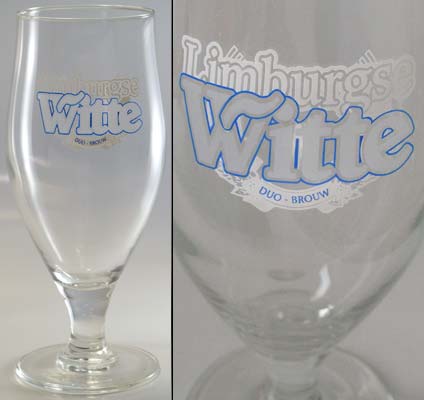
Brouwerij St. Jozef in Opitter also had a hand in this glass. Together with Brouwerij Martens in Bocholt, they made the Limburgse Witte duo-brouw, a delicately spiced wheat beer (known as a witbier).
Kasteelbier glass
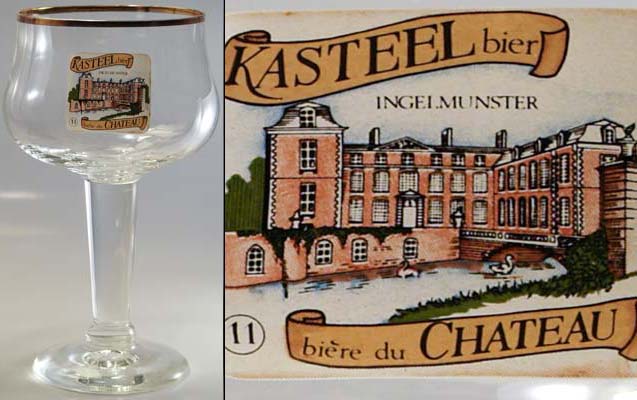
This elegant gold-rimmed glass would make a very decorative addition to any festive holiday table. Kasteelbier is a very strong (11%), reddish-colored beer that would sparkle beautifully in candlelight.
The picture on the glass is of a castle in Ingelmunster, the city in the province of West-Vlaanderen where the brewery (Brouwerij van Honsebrouck) is located.
24 Hours of Belgian Beer tasting glasses
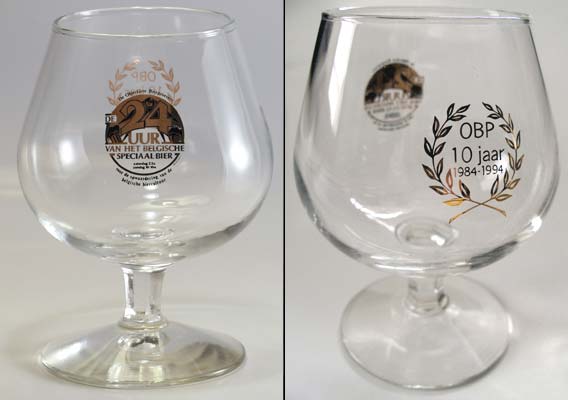
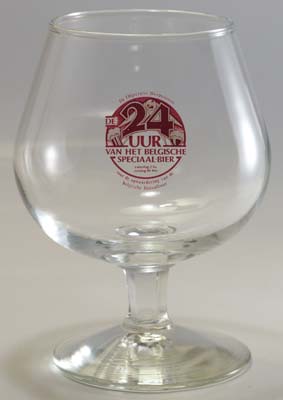
These small glasses served as tasting glasses for the many special beers found at the annual 24 Hours of Belgian Beers, a celebration that takes place every November in Antwerp. The 1995 version of the glass depicts the logo in purple. The 1994 gold version also has logo of the OBP (Objectieve BierProevers), the beer club that hosts this and a wide variety of other beer events.
Palm Speciale glasses


Thes tapered bowl glasses are from Brouwerij Palm, located in the province of Brabant. To this day the brewery still has traditional beer wagons that are pulled by enormous Belgian horses.
The beer that fills this glass is a very lovely, mild amber beer. It is a beer for any occasion and therefore is equally as good as a dessert as well as with a meal. It also makes a lovely substitue for water when baking bread!
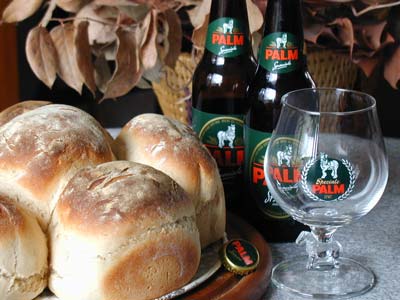
home-baked beer bread
Grimbergen glass
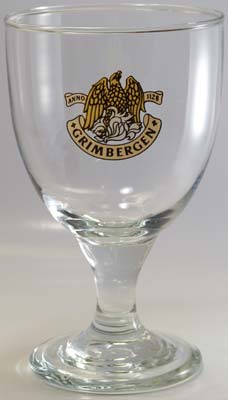
The Grimbergen abbey was founded in the province of Brabant back in 1128 by the Holy Norbertus. The abbey makes several beers ranging from light to dark in color and from 6.5 - 10 % in alcohol content. All of them are extremely delicious and the wide bowl glass helps bring out the beers' many lovely aromas. The labels are also works of art.
Leffe glass
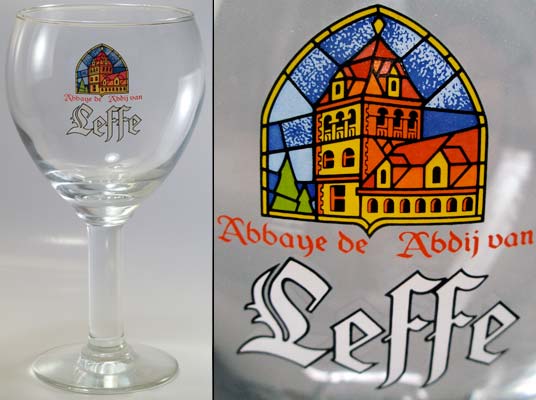
The Abbaye de Leffe was founded in the year 1240 in Dinant, located in the southern province of Namur. This lovely long stemmed glass has a very large bowl designed for holding the abbey's assortment of strong tasty beers whose alcohol content range from 6.5 - 8.2%. The logo on the glass is presumably that of the abbey itself. The brewery is currently owned by Interbrew.
Primus Haacht Pils glass
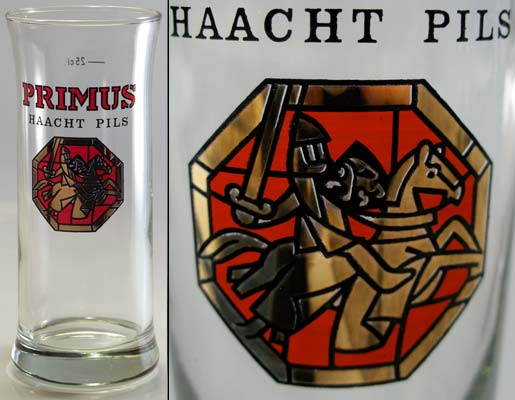
The name Haacht comes from the brewery that makes this beer, Brouwerij Haacht. The name Primus most likely refers to the armed knight on his horse, a famous legendary brewer of the area. The straight narrow glass is meant for the brewery's pilsener style beer. They make both a normal clear pils as well as a delicious special unfiltered pils, Primus ‘98.
Belle-Vue Kriek glass
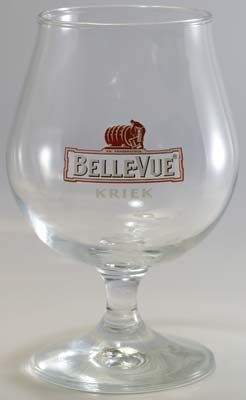
Brasserie Belle-Vue has chosen this bowl-shaped glass with a narrow top for their special Kriek (cherry) beer. Kriek is a very special type of Belgian beer known as lambic. Lambic can be made in a variety of flavors including plain (refered to as geuze), cherry, raspberry, strawberry, black currant, peach and even banana.
Since it is made using a unique type of wild yeast, this sort of beer can only be made in the area around Brussels. After it is brewed, it must be stored in large oak barrels for a long time to ripen. The small picture on the glass shows a brewer next to one of these giant barrels.
Gouden Carolus glass
The bright gold medallion painted on this bowl-shaped glass depicts the image of "Carolus" (or Charlemagne) on his horse. The glass is ideal for slowly sipping the 7.5% alcohol beer with its slight licorice taste.
The beer comes from a brewery in northern Belgium, and it is obvious from this glass that Belgium is a country with two national languages. The top words "Gouden Carolus" on the glass are in Flemish (closely related to Dutch) while the bottom words "Carolus D’Or" are in Walloon (related to French). Both mean "Golden Charlemagne". The brewery is named either Brouwerij het Anker or Brasserie de L’ancre and is located in either Mechelen or Malines, depending on your choice of language.
Rodenbach glasses

Everything about Rodenbach beer reminds one of a mild red wine, from its deep red color and tart vinous taste all the way down to the shape of its glass. Fortunately the small green picture of hop leaves and a cone are there to remind us that it is still a beer.
The name Rodenbach on the glass pertains both to the brewery and the man who founded it. Long ago, the surgeon Ferdinand Rodenbach moved from Austria and made the city of Roeselare his home. In 1820, his blind grandson Alexander bought a brewery there.
The glass on the left was the gift that started the entire Vermin Brewing collection.
Dentergems glass
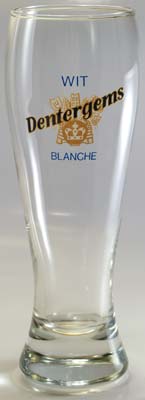
This tall slender glass has a narrow base and thick solid glass foot. The words Wit and Blanche written on the glass mean “white” in Dutch and French respectively, and stand for the type of beer that this glass is meant to contain. Wit Bier or Biere Blanche is a deliciously spiced, mild wheat beer.
This particular beer comes from the N.V. Riva S.A. brewery located in Dentergem, and is also exported to the USA.
Trappistes Rochefort glass
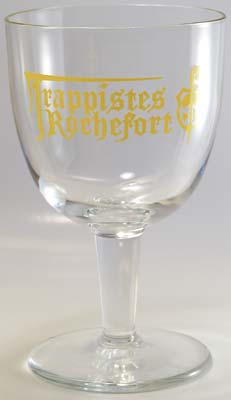
This large bowl glass with a sturdy base is meant to hold the Trappist beers from the Abbaye Notre Dame de St. Rémy located in Rochefort, a city in the southern province of Namur. Both types of beers made by the monks, the “8” and the “10”, contain a lovely roasted flavor and a very high alcohol content.
De Kluis glass

The most noteworthy part of this thick, sturdy glass by Brouwerij De Kluis (renamed from Brouwerij Hoegaarden in 1979) is its beautiful twisted stem. The large bowl part of the glass is capable of holding relatively large amounts of liquid, which is somewhat surprising given that one might most likely use this glass to consume the brewery's 9.0% alcohol beer, De Verboden Vrucht (Dutch for "forbidden fruit").
The logo on the glass depicts traditional brewing equipment ringed by hops and barley. The two shields, one of a yellow lion and the other of a bishop's staff, are presumably symbols of Hoegaarden (the city in which the brewery is located).
Hoegaarden glass

Produced by the same brewery as above, this glass is meant to hold a refreshing witbier, a light wheat beer flavored with citrus and spices.
Moeder Overste glass
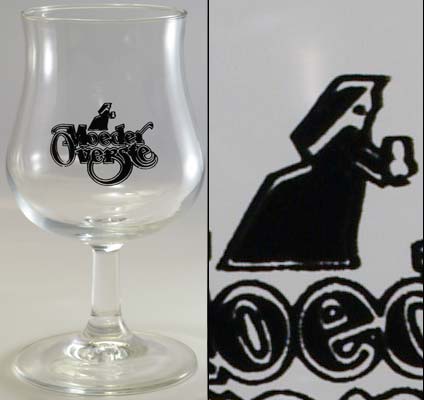
This shapely slender glass with a wide stable foot is designed to hold an 8.0% dark beer known as Moeder Overste (the Dutch word for Mother Superior). While the logo on the glass is indeed that of a nun carrying a large mug, the beer supposedly doesn't get its name from the Christian religion but rather from the Dutch words "moederbrouwsel + superieure kwaliteit" (mother brew + superior quality).
The brewery, Brasserei Lefèbvre, is located in Quenast, in Belgium's northernmost province of Brabant, which borders with the Netherlands.
Floreffe glass
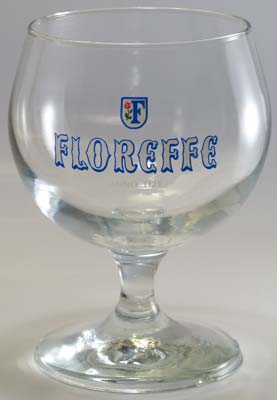
The same brewery also offers this lovely little glass. Brewed with license from the Abdij Floreffe (an abbey founded in 1121 by the Holy Norbertus), the strong blond beer meant to fill this glass is a Belgian abbey style ale known as a triple.
Maes Cool Beer glass

This frosted glass is designed to hold Maes Cool Beer, an "ice beer"of 5.7% alcohol brewed by Brouwerij Alken-Maes. This 25 cl (centiliter) glass bears the logo of the brewery, which depicts two men carrying a barrel of beer between them by having tied it to a long pole that rests on their shoulders. The date under the brewery logo reads 1880. The glass gets semi-clear when wet, but then tends to be a bit slippery to hold on to.
The brewery itself is located in the city of Kontich/Waarloos. It produces large quantities and many different sorts of beer. It also brews special beers for other breweries that may not have the proper facilities and it also helps with the distribution of said beers.
Manneken Pis glass
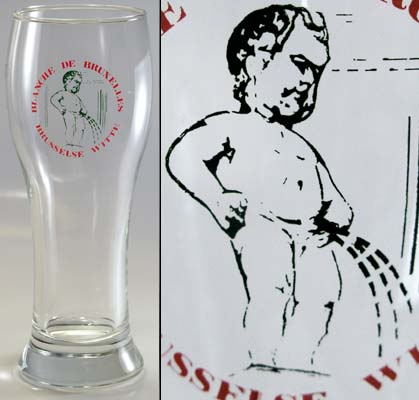
Manneken Pis (translated from Dutch as "little man pissing") is a small bronze fountain sculpture in the city of Brussels (also known as Bruxelles). There are many legends behind this statue, but all end with the image pictured above.
Unfortunately there is no mention of the brewery on the glass, although the type of beer it is meant to hold is a delicious Belgian wheat beer, known as a Wit or Blanche.
Bush glass

This glass is meant to hold any of Brouwerij Dubuisson's amazingly delicious orange-amber beers. All of the Bush regular and seasonal beers are high in alcohol, ranging from 7.5% to 12%.
The brewery is located in Pipaix in the province of Hainaut. The letters on the glass are actually in gold, but they tend to change color with the light.
Ciney glass
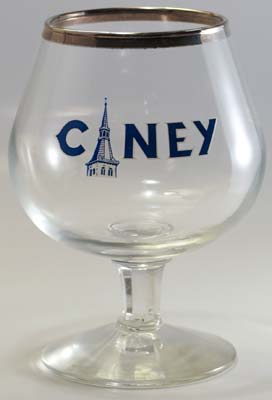
This charming small glass rimmed with silver is the perfect size for sipping the various Ciney beers. Ranging in alcohol from 7% to 9%, the beers come in either a blond or brown style.
The steeple logo on the glass is presumably a landmark in the city of Ciney, where the Demarche Brewery is located, or perhaps it is even part of the brewery itself.
De Troch glass
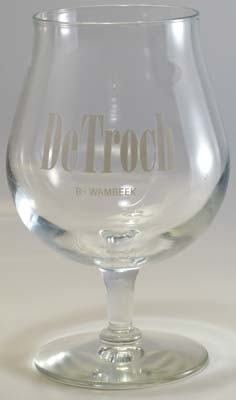
It would be very difficult to get bored with the wide range of fruit beers that are meant to fill this elegant glass. Some of the various flavors include banana, pineapple, apple, strawberry, cherry and peach. With an alcohol content of only 3%, it's hard to believe it is actually beer. The brewery also makes a geuze (basically the plain sour beer without any fruit added).
Brasserie or Brouwerij de Troch is located in the city of Wambeek in the province of Brabant. Both the brewery and city name are on the glass.
Duvel glass

It's hard to believe that this giant glass is meant to hold an 8.5% beer, but the strong blond beer is surprisingly extremely drinkable. The gold letters on the glass give us the name of the beer, Duvel, probably stemming from the Dutch word 'duivel' which means devil.
The brewery, Brouwerij Moortgat, is located in Breendonk in the province of Antwerpen. It was founded in 1871 by Jean-Leonard Moortgat but has since transferred out of family hands.
Hapkin glass

This enormous glass is meant to hold the powerful Hapkin blond beer. The name comes from Boudewijn VII, who was the count of Flanders from 1111 - 1119. His got the nickname Hapkin since he always carried a small axe with him.
Hapkin originally had this beer brewed by the abbey Ter Duinen. In 1877, Brouwerij Louwaege (a brewery located in Kortemark in the province of West-Vlaanderen) took over. In 2002, ownership transferred again to Brouwerij Alken-Maes.
Wittekerke glass

Wittekerke was actually brewed for the Belgian sitcom with the same name. The name, which translates from Dutch to White Church, is meant as a fictional name for a typical Flemish town. The actors actually drink the witbier (or spiced wheat beer) during the show.
It is brewed by Bavik, a brewery in Bavikhove in the province of West Flanders. They make a wide variety of beers and labels.
![]()
vbteam@verminbrewing.com
2007
